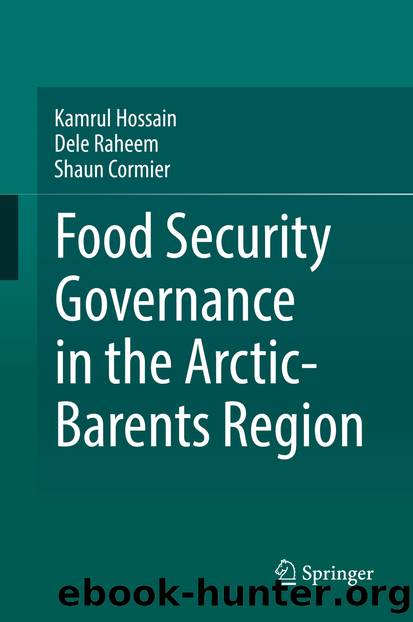Food Security Governance in the Arctic-Barents Region by Kamrul Hossain Dele Raheem & Shaun Cormier

Author:Kamrul Hossain, Dele Raheem & Shaun Cormier
Language: eng
Format: epub
Publisher: Springer International Publishing, Cham
The findings showed that the level of contamination of copper, nickel, arsenal, cadmium, lead, mercury, polychlorinated biphenyls, hexachlorobenzene, dioxins and furans ranged from low to moderate and were considered safe for consumption. However, there were geographical differences—the levels were higher along the Russian border—and there is a need for further research.
Although the research on contaminants and pollutants entering the Arctic has been primarily directed at the North American Arctic, there are some studies and reports, such as the AMAP 2015 report, that briefly looked at the European and Russian Arctic, too. In Norway, the levels of most POPs have declined significantly since 1979 in a single cohort of Norwegian men. This is consistent with the expected reduction in environmental exposure following international action across several decades to reduce or eliminate the production or use of POPs (Nøst et al. 2013). However, AMAP has documented that the consumption of marine mammals and fish was associated with increased levels of PFOS, PFNA, PFDA and PFUnDA and that beef consumption was significantly associated with increased levels of PFOA.
The consumption of game (e.g., reindeer, moose and grouse) was significantly associated with increased levels of PFHxS, PFHpS and PFNA (Nøst et al. 2013). In Sweden, the concentration of POPs in breast milk and its serum were found to be decreasing, with no strong indication of a generally higher concentration in northern Sweden in comparison to other parts of Sweden, which could be the general trend in the Arctic (AMAP 2015). This trend can be explained in relation to the highly centralized food distribution system in the Barents region nowadays.
The overall conclusion was that as long as store-bought foods make up the main proportion of the diet, there are only small or no regional differences in POP exposure at a population level (Glynn et al. 2011). Fish do remain a significant source of exposure to contaminants in Sweden, where the biomarkers of fish consumption correlate well with serum levels of PFOS, PFNA, PFDA and PFUnDA (Wennberg et al. 2007; Bjermo et al. 2013). In Finland, breast milk analyses in food sources from most store-bought foods have relatively low levels of PCBs (Kiviranta et al. 2001). There are elevated levels present in seafood originating from the Baltic Sea, but this is due to known PCB pollution in the Baltic Sea, which mainly concerns people consuming seafood in southern Finland and not in the North. In Russia, a study of male and female volunteers from Nelmin-Nos in the Nenets AO and Izhma and Usinsk in the Komi Republic indicated that older people in these northwestern Russian communities have significantly higher blood concentrations of many contaminants that accumulate in people over time, and higher PCBs and Pb were noticed in men compared to women (AMAP 2015).
Izhma is a small community mainly populated by reindeer herders, and the study showed that men have significantly higher concentrations of HCB, whereas overall the whole group has higher concentrations of cadmium (Cd). The group from Usinsk had higher concentrations of selenium (Se) and
Download
This site does not store any files on its server. We only index and link to content provided by other sites. Please contact the content providers to delete copyright contents if any and email us, we'll remove relevant links or contents immediately.
| Automotive | Engineering |
| Transportation |
Whiskies Galore by Ian Buxton(40334)
Introduction to Aircraft Design (Cambridge Aerospace Series) by John P. Fielding(32338)
Small Unmanned Fixed-wing Aircraft Design by Andrew J. Keane Andras Sobester James P. Scanlan & András Sóbester & James P. Scanlan(32141)
Craft Beer for the Homebrewer by Michael Agnew(17447)
Turbulence by E. J. Noyes(7041)
The Complete Stick Figure Physics Tutorials by Allen Sarah(6639)
Kaplan MCAT General Chemistry Review by Kaplan(6054)
The Thirst by Nesbo Jo(5786)
Bad Blood by John Carreyrou(5770)
Learning SQL by Alan Beaulieu(5412)
Weapons of Math Destruction by Cathy O'Neil(5038)
Man-made Catastrophes and Risk Information Concealment by Dmitry Chernov & Didier Sornette(4738)
iGen by Jean M. Twenge(4702)
Digital Minimalism by Cal Newport;(4545)
Life 3.0: Being Human in the Age of Artificial Intelligence by Tegmark Max(4509)
Audition by Ryu Murakami(4099)
1,001 ASVAB Practice Questions For Dummies by Powers Rod(4039)
Electronic Devices & Circuits by Jacob Millman & Christos C. Halkias(4029)
Pale Blue Dot by Carl Sagan(4003)
